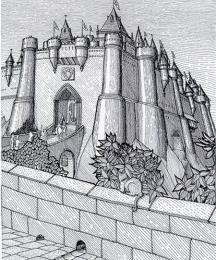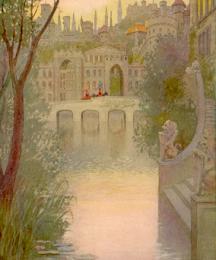
Although Camelot is, for most modern readers, the legendary center of King Arthur's realm, in many medieval texts Arthur holds court at Carleon or some other city. Camelot is first mentioned in line 34 of Chrétien de Troyes's Lancelot; and the name does not appear in all manuscripts of that poem. In the thirteenth-century Vulgate Cycle, Camelot becomes the principal city of King Arthur's realm and remains so in many, though certainly not all, later texts. For the English-speaking world Camelot is Arthur's central city because of Malory, who identifies it with Winchester. The image many modern readers have of the Camelot coincides with Tennyson's description of it in Tennyson's "The Lady of Shalott" as "many-tower'd Camelot." Tennyson's image of Camelot is much more complex, however, in "Gareth and Lynette" in The Idylls of the King where it is descibed as a City built to music and where it is suggestive of Tennyson's theme of appearance and reality "For there is nothing in it as it seems / Saving the King." Since Camelot is a legendary place, it is perhaps futile to speak of its location. However, John Leland identified it with Cadbury Castle. Excavations carried out at the site in 1966-1970 confirmed that this large hill fort (with 1200 yards of perimeter surrounding an eighteen-acre enclosure and rising about 250 feet above the surrounding countryside) was refortified in the Arthurian era and was occupied by a powerful leader and his followers. More recently, largely through the influence of T. H. White, Camelot has come to be associated with the values Camelot is believed to have represented (White's "Might for Right"). The moral overtones still often remain...
Read More
Read More
Bradley, William Aspenwall (1878 - 1939)
Cawein, Madison J. (1865 - 1914)
Leland, John (c. 1503 - 1552)
Lupack, Alan (1946 - )
Roberts, Theodore Goodridge (1877 - 1953)
Sladen, Douglas B. W. (1856 - 1947)
Weston, Jessie (1850 - 1928)
Dan Beard (1850 - 1941)
Ian Brown (b. 1962)
Alfred Kappes (1850 - 1894)
M. L. Kirk (1860 - 1938)
Howard Pyle (1853 - 1911)

Dan Beard (1850 - 1941)
Ian Brown (b. 1962)

Alfred Kappes (1850 - 1894)

M. L. Kirk (1860 - 1938)

Howard Pyle (1853 - 1911)











